Page 325 of 364
315
ENGINE OIL SELECTION
“Toyota Genuine Motor Oil” is used in
your Toyota vehicle. Use Toyota approved
“Toyota Genuine Motor Oil” or equivalent
to satisfy the following grade and viscos-
ity.
Oil grade:API grade, SL “Energy −Conserving” or
ILSAC multigrade engine oil
Recommended viscosity:
SAE 5W −30
Outside temperature
SAE 5W�30 is the best choice for good
fuel economy, and good starting in cold
weather.
If SAE 5W�30 oil is not available, SAE
10W�30 oil may be used. However, it
should be replaced with SAE 5W�30 at
the next oil change.
API service symbol
ILSAC certification mark
Page 326 of 364
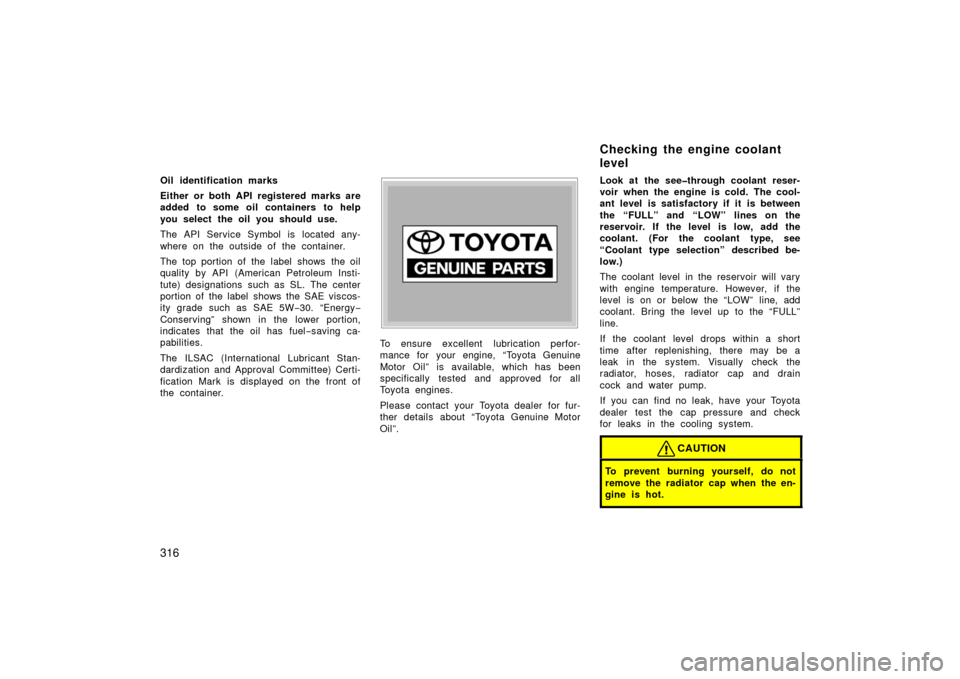
316
Oil identification marks
Either or both API registered marks are
added to some oil containers to help
you select the oil you should use.
The API Service Symbol is located any-
where on the outside of the container.
The top portion of the label shows the oil
quality by API (American Petroleum Insti-
tute) designations such as SL. The center
portion of the label shows the SAE viscos-
ity grade such as SAE 5W−30. “Energy −
Conserving” shown in the lower portion,
indicates that the oil has fuel −saving ca-
pabilities.
The ILSAC (International Lubricant Stan-
dardization and Approval Committee) Certi-
fication Mark is displayed on the front of
the container.
To ensure excellent lubrication perfor-
mance for your engine, “Toyota Genuine
Motor Oil” is available, which has been
specifically tested and approved for all
Toyota engines.
Please contact your Toyota dealer for fur-
ther details about “Toyota Genuine Motor
Oil”. Look at the see�through coolant reser-
voir when the engine is cold. The cool-
ant level is satisfactory if it is between
the “FULL” and “LOW” lines on the
reservoir. If the level is low, add the
coolant. (For the coolant type, see
“Coolant type selection” described be-
low.)
The coolant level in the reservoir will vary
with engine temperature. However, if the
level is on or below the “LOW” line, add
coolant. Bring the level up to the “FULL”
line.
If the coolant level drops within a short
time after replenishing, there may be a
leak in the system. Visually check the
radiator, hoses, radiator cap and drain
cock and water pump.
If you can find no leak, have your Toyota
dealer test the cap pressure and check
for leaks in the cooling system.
CAUTION
To prevent burning yourself, do not
remove the radiator cap when the en-
gine is hot.
Checking the engine coolant
level
Page 327 of 364
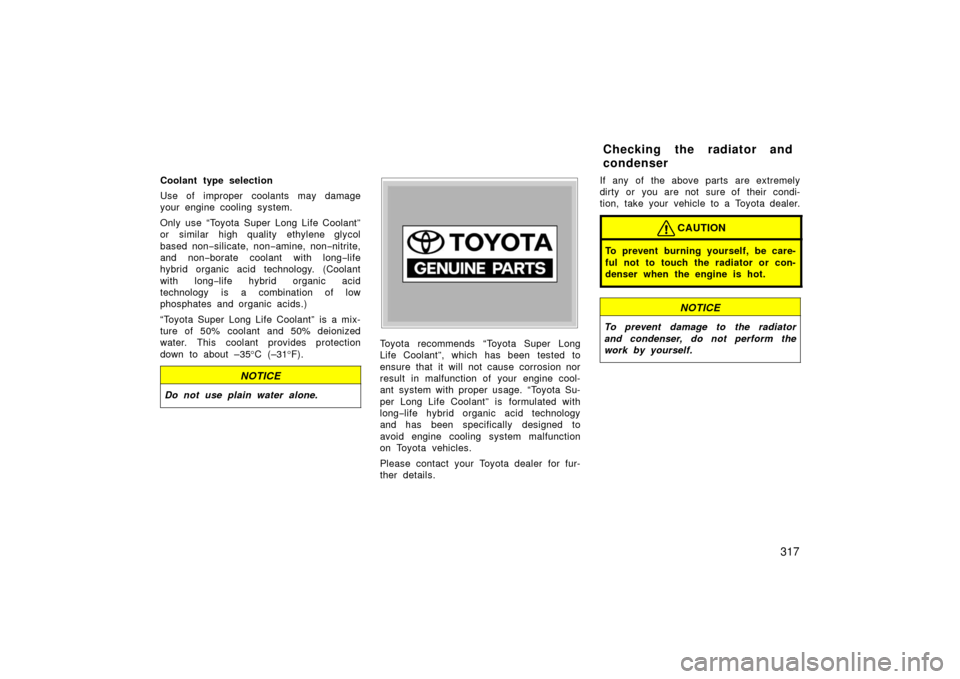
317
Coolant type selection
Use of improper coolants may damage
your engine cooling system.
Only use “Toyota Super Long Life Coolant”
or similar high quality ethylene glycol
based non−silicate, non −amine, non− nitrite,
and non− borate coolant with long −life
hybrid organic acid technology. (Coolant
with long −life hybrid organic acid
technology is a combination of low
phosphates and organic acids.)
“Toyota Super Long Life Coolant” is a mix-
ture of 50% coolant and 50% deionized
water. This coolant provides protection
down to about –35 °C (–31 °F).
NOTICE
Do not use plain water alone.
Toyota recommends “Toyota Super Long
Life Coolant”, which has been tested to
ensure that it will not cause corrosion nor
result in malfunction of your engine cool-
ant system with proper usage. “Toyota Su-
per Long Life Coolant” is formulated with
long− life hybrid organic acid technology
and has been specifically designed to
avoid engine cooling system malfunction
on Toyota vehicles.
Please contact your Toyota dealer for fur-
ther details. If any of the above parts are extremely
dirty or you are not sure of their condi-
tion, take your vehicle to a Toyota dealer.
CAUTION
To prevent burning yourself, be care-
ful not to touch the radiator or con-
denser when the engine is hot.
NOTICE
To prevent damage to the radiator
and condenser, do not perform the
work by yourself.
Checking the radiator and
condenser
Page 328 of 364
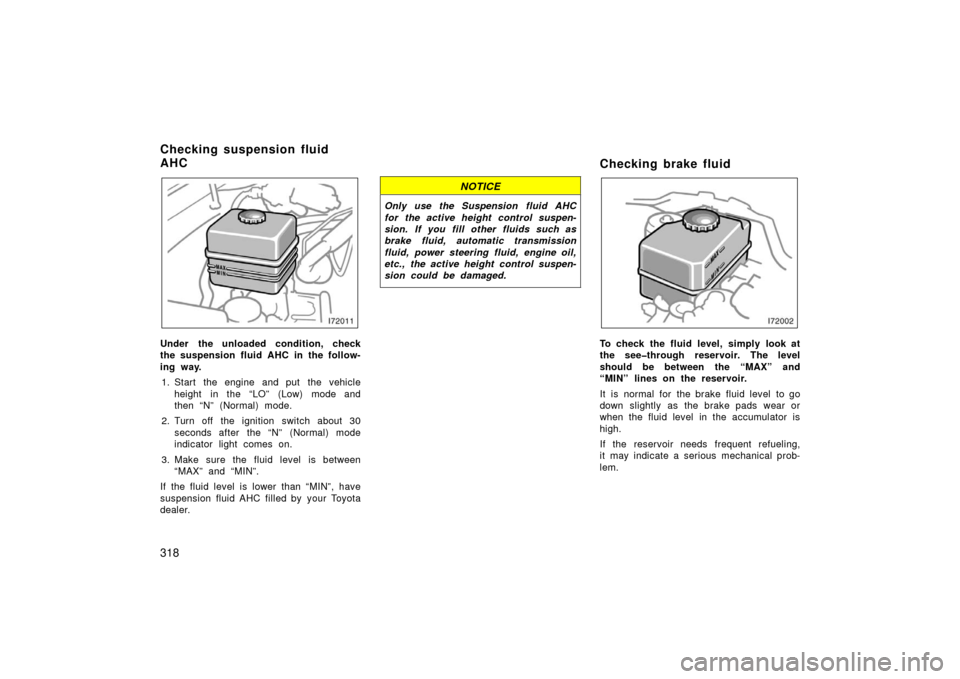
318
Under the unloaded condition, check
the suspension fluid AHC in the follow-
ing way.1. Start the engine and put the vehicle height in the “LO” (Low) mode and
then “N” (Normal) mode.
2. Turn off the ignition switch about 30 seconds after the “N” (Normal) mode
indicator light comes on.
3. Make sure the fluid level is between “MAX” and “MIN”.
If the fluid level is lower than “MIN”, have
suspension fluid AHC f illed by your Toyota
dealer.
NOTICE
Only use the Suspension fluid AHC
for the active height control suspen-
sion. If you fill other fluids such as
brake fluid, automatic transmission
fluid, power steering fluid, engine oil,
etc., the active height control suspen-
sion could be damaged.
Checking brake fluid
To check the fluid level, simply look at
the see�through reservoir. The level
should be between the “MAX” and
“MIN” lines on the reservoir.
It is normal for the brake fluid level to go
down slightly as the brake pads wear or
when the fluid level in the accumulator is
high.
If the reservoir needs frequent refueling,
it may indicate a serious mechanical prob-
lem.
Checking suspension fluid
AHC
Page 329 of 364
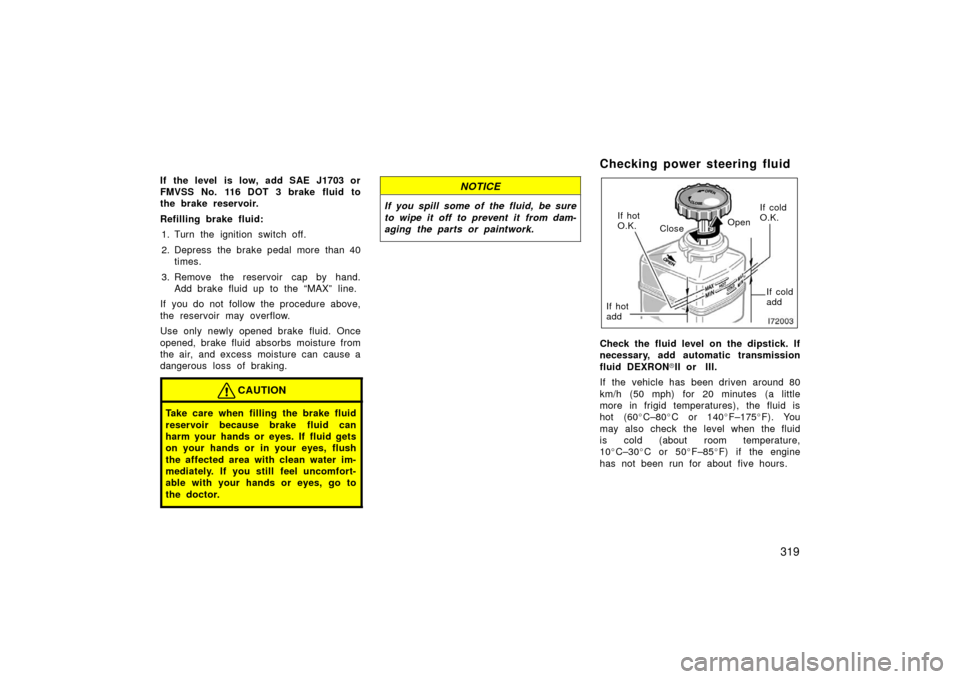
319
If the level is low, add SAE J1703 or
FMVSS No. 116 DOT 3 brake fluid to
the brake reservoir.
Refilling brake fluid:1. Turn the ignition switch off.
2. Depress the brake pedal more than 40 times.
3. Remove the reservoir cap by hand. Add brake fluid up to the “MAX” line.
If you do not follow the procedure above,
the reservoir may overflow.
Use only newly opened brake fluid. Once
opened, brake fluid absorbs moisture from
the air, and excess moisture can cause a
dangerous loss of braking.
CAUTION
Take care when filling the brake fluid
reservoir because brake fluid can
harm your hands or eyes. If fluid gets
on your hands or in your eyes, flush
the affected area with clean water im-
mediately. If you still feel uncomfort-
able with your hands or eyes, go to
the doctor.
NOTICE
If you spill some of the fluid, be sure
to wipe it off to prevent it from dam-
aging the parts or paintwork.
Checking power steering fluid
Open
Close If cold
O.K.
If cold
add
If hot
O.K.
If hot
add
Check the fluid level on the dipstick. If
necessary, add automatic transmission
fluid DEXRON \bII or III.
If the vehicle has been driven around 80
km/h (50 mph) for 20 minutes (a little
more in frigid temperatures), the fluid is
hot (60 �C–80 �C or 140 �F–175 �F). You
may also check the level when the fluid
is cold (about room temperature,
10 �C–30 �C or 50 �F–85 �F) if the engine
has not been run for about five hours.
Page 341 of 364

331
NOTICE
�Be sure the engine and all accesso-
ries are off before performing main-
tenance.
� When checking the battery, remove
the ground cable from the negative
terminal (“–” mark) first and rein-
stall it last.
� Be careful not to cause a short cir-
cuit with tools.
� Take care no solution gets into the
battery when washing it.
If the battery terminal is disconnected
or the battery is run down, the moon
roof may not operate automatically and
the jam protection function will not operate
correctly after you reconnect, replace or
recharge the battery with the moon roof
slide −opened or tilted up. In any of these
cases, you should return the moon roof to
normal. To return the moon roof to normal,
see “Electric moon roof” on page 31.
—Checking battery c ondition
Ty p e A
Ty p e BGreen Dark Clear or
light yellow
Blue White Red
CHECKING BY INDICATOR
Check the battery condition by the indi-
cator color. Indicator color
ConditionTy p e ATy p e B
GreenBlueGood
DarkWhite
Charging necessary.
Have battery
checked by your
Toyota dealer.
Clear or
light
yellow
Red
Have battery
checked by your
Toyota dealer.
Battery recharging precautions
During recharging, the battery is pro-
ducing hydrogen gas.
Therefore, before recharging:1. If recharging with the battery installed on the vehicle, be sure to disconnect
the ground cable.
2. Be sure the power switch on the re- charger is off when connecting the
charger cables to the battery and when
disconnecting them.
CAUTION
�Always charge the battery in an un-
confined area. Do not charge the
battery in a garage or closed room
where there is not sufficient ventila-
tion.
�Only do a slow charge (5 A or
less). Charging at a quicker rate is
dangerous. The battery may ex-
plode, causing personal injuries.
NOTICE
Never recharge the battery while the
engine is running. Also, be sure all
accessories are turned off.
Page 343 of 364
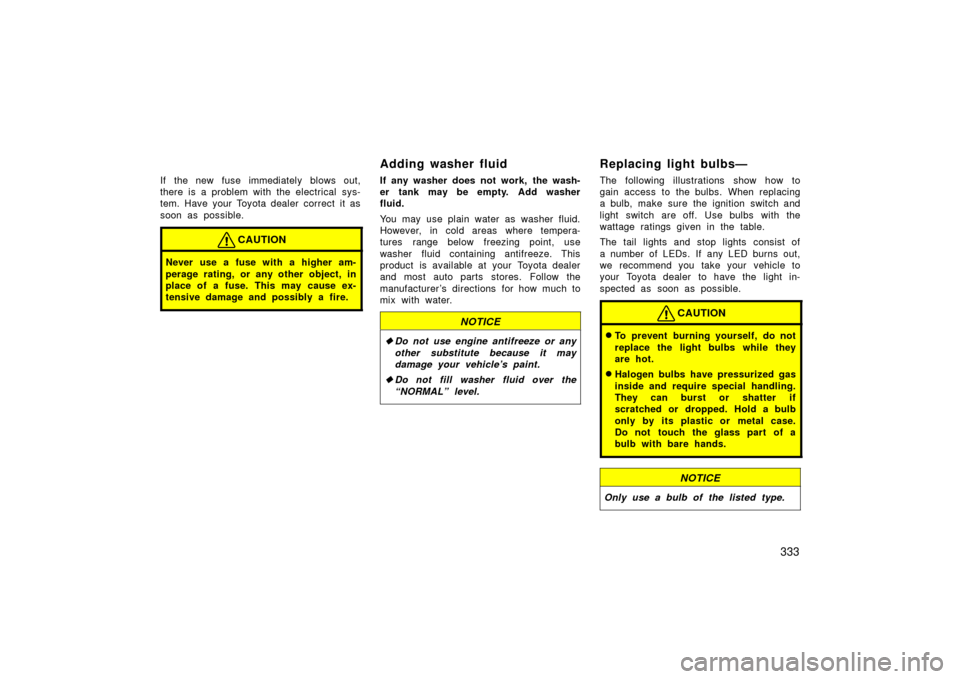
333
If the new fuse immediately blows out,
there is a problem with the electrical sys-
tem. Have your Toyota dealer correct it as
soon as possible.
CAUTION
Never use a fuse with a higher am-
perage rating, or any other object, in
place of a fuse. This may cause ex-
tensive damage and possibly a fire.
Adding washer fluid
If any washer does not work, the wash-
er tank may be empty. Add washer
fluid.
You may use plain water as washer fluid.
However, in cold areas where tempera-
tures range below freezing point, use
washer fluid containing antifreeze. This
product is available at your Toyota dealer
and most auto parts stores. Follow the
manufacturer’s directions for how much to
mix with water.
NOTICE
�Do not use engine antifreeze or any
other substitute because it may
damage your vehicle’s paint.
� Do not fill washer fluid over the
“NORMAL” level.
Replacing light bulbs—
The following illustrations show how to
gain access to the bulbs. When replacing
a bulb, make sure the ignition switch and
light switch are off. Use bulbs with the
wattage ratings given in the table.
The tail lights and stop lights consist of
a number of LEDs. If any LED burns out,
we recommend you take your vehicle to
your Toyota dealer to have the light in-
spected as soon as possible.
CAUTION
�To prevent burning yourself, do not
replace the light bulbs while they
are hot.
�Halogen bulbs have pressurized gas
inside and require special handling.
They can burst or shatter if
scratched or dropped. Hold a bulb
only by its plastic or metal case.
Do not touch the glass part of a
bulb with bare hands.
NOTICE
Only use a bulb of the listed type.
Page 349 of 364
339
SPECIFICATIONS
Dimensions and weightss340
. . . . . . . . . . . . . . . . . . . . . . . . . . . . . . . . . . .
Engine 340
. . . . . . . . . . . . . . . . . . . . . . . . . . . . . . . . . . . . \
. . . . . . . . . . . . . . . .
Fuel 340
. . . . . . . . . . . . . . . . . . . . . . . . . . . . . . . . . . . . \
. . . . . . . . . . . . . . . . . . .
Service specifications 341
. . . . . . . . . . . . . . . . . . . . . . . . . . . . . . . . . . . . \
. . .
Tires 344
. . . . . . . . . . . . . . . . . . . . . . . . . . . . . . . . . . . . \
. . . . . . . . . . . . . . . . . .
Fuses 345
. . . . . . . . . . . . . . . . . . . . . . . . . . . . . . . . . . . . \
. . . . . . . . . . . . . . . . .
SECTION 8